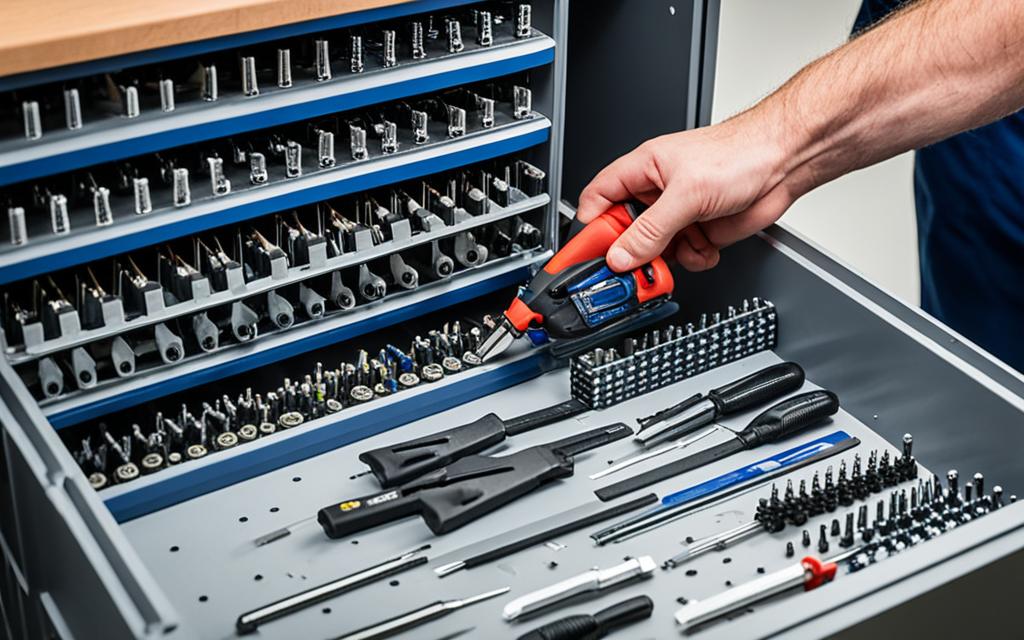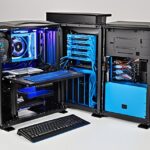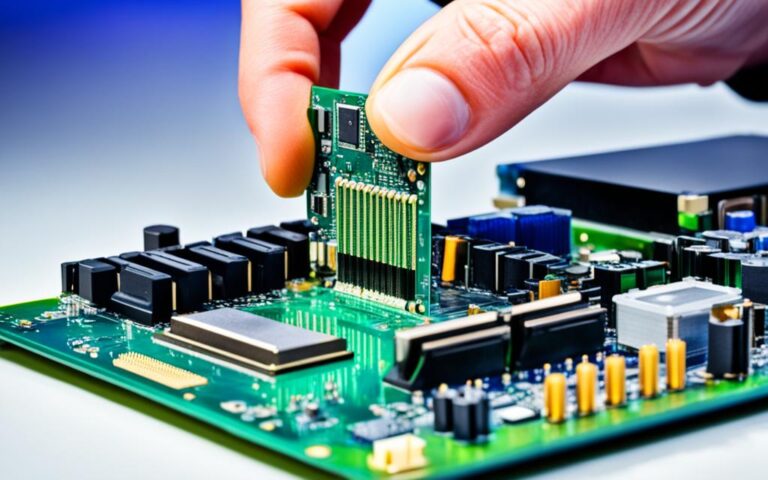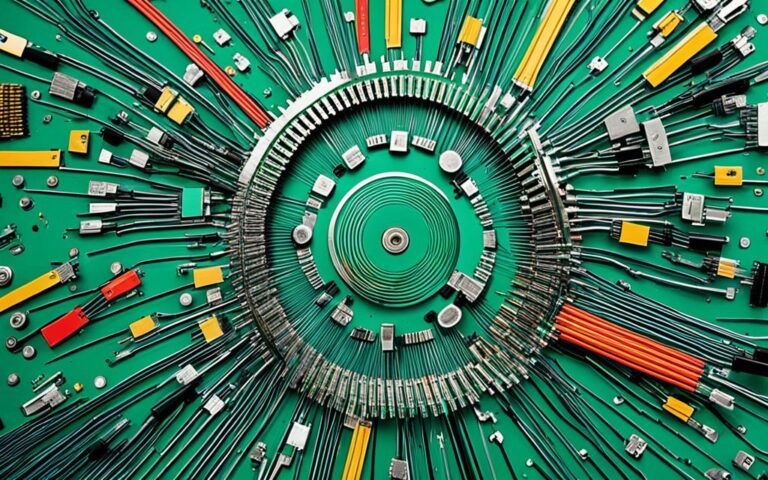Mastering Responsible PC Disassembly
Responsible PC disassembly is a vital skill in the digital age, enabling you to customize, troubleshoot, and upgrade your desktop PC. By mastering the art of PC disassembly, you not only gain control over your computing experience but also contribute to eco-friendly practices such as PC recycling.
As technology continues to advance at a rapid pace, it’s important to be equipped with the knowledge and skills necessary to handle PC components responsibly. By disassembling your PC properly, you can ensure that valuable resources are recycled and reused, reducing environmental impact and promoting sustainability.
In this comprehensive guide, we will take you through the step-by-step process of responsible PC disassembly, providing you with valuable insights into components, wiring, and safety procedures. Whether you’re a computer enthusiast or a professional in the IT industry, this guide will equip you with the tools and knowledge you need to make a positive impact.
Let’s dive into the world of responsible PC disassembly, where we combine technical expertise with eco-friendly practices, shaping a better future for our environment.
Tools and Equipment for Desktop PC Assembling and Disassembling
Before you begin the process of assembling or disassembling a desktop PC, it is important to ensure that you have the right tools and equipment at your disposal. These tools will not only make the process easier but also help prevent any damage to the sensitive components of your PC. Here is a list of essential tools and equipment you should have:
- A PC toolkit containing a variety of precision screwdrivers with different head types, such as Phillips, flathead, and Torx. These screwdrivers will be used to secure components like the motherboard and power supply.
- An anti-static wrist strap is crucial for discharging any static electricity that could potentially harm the delicate PC components. It is a preventive measure to ensure the safety of your PC during the assembly or disassembly process.
- Cable ties or Velcro straps will help you manage and organize the cables inside your PC, ensuring a tidy and clutter-free build.
- Needle-nose pliers are handy for gripping and manipulating small components or wires.
- A flashlight or headlamp will be useful for illuminating tight spaces inside your PC, allowing you to see clearly during disassembly or assembly.
- Cable management clips can be helpful for keeping cables in place and preventing them from obstructing airflow or interfering with other components.
Ensure that you have all the necessary tools in good condition and within reach before you start the process. This will save you time and frustration during your PC assembly or disassembly and ensure a successful outcome.
| Tool | Purpose |
|---|---|
| Precision screwdrivers | Securing components |
| Anti-static wrist strap | Discharge static electricity |
| Cable ties or Velcro straps | Cable management |
| Needle-nose pliers | Manipulating small components or wires |
| Flashlight or headlamp | Illuminating tight spaces |
| Cable management clips | Keeping cables in place |
Safety Procedures for Desktop PC Assembling and Disassembling
Working with desktop PCs involves delicate components and electrical connections, so it’s important to prioritize safety. To prevent static discharge, wear an anti-static wrist strap and work on an anti-static mat if available. Before starting any work, ensure that the PC is completely powered off and disconnected from the electrical outlet. Keep your workspace clean and clutter-free, use proper handling techniques, and avoid placing components on surfaces that generate static electricity. Use the right tools, organize and label cables, and refer to the manuals for guidance on installation and compatibility. Follow these safety procedures to minimize the risk of accidents and damage to components.
“Safety should always be your top priority when dealing with desktop PCs. Taking the necessary precautions can prevent costly accidents and ensure a smooth assembly or disassembly process.”
Static Electricity Precautions
- Wear an anti-static wrist strap to prevent static discharge.
- Work on an anti-static mat if available.
Disconnect Power
- Ensure that the PC is completely powered off.
- Disconnect the PC from the electrical outlet.
Proper Handling
- Use proper handling techniques to avoid damaging delicate components.
- Avoid placing components on surfaces that generate static electricity.
Toolkit Essentials:
| Tool | Description |
|---|---|
| Precision screwdriver set | Includes various head types like Phillips, flathead, and Torx to secure components |
| Anti-static wrist strap | Discharges static electricity to protect sensitive PC components |
| Cable ties or Velcro straps | Helps with cable management during PC assembly and disassembly |
| Needle-nose pliers | Assists with handling small components and wires |
| Flashlight or headlamp | Provides additional lighting in tight spaces |
| Cable management clips | Keeps cables organized and reduces clutter |
By following these safety procedures and using the proper tools, you can ensure a smooth and risk-free desktop PC assembling and disassembling experience. Taking these precautions will not only protect your valuable components but also prevent any accidents or damage.
Preparing Your Workspace for Desktop PC Assembling and Disassembling
A well-prepared workspace is crucial for ensuring a smooth and safe desktop PC assembly and disassembly process. By creating an environment that meets the necessary requirements, you can optimize your efficiency and minimize the risk of damaging components. Here are some key steps to follow:
- Choose a suitable location: Select a clean, well-lit, and spacious area to work in. This will provide you with ample room to maneuver and reduce the chances of accidentally knocking over objects or causing obstructions.
- Ground yourself: Before handling any PC components, it’s essential to discharge any static electricity that could potentially damage sensitive electronics. Wear an anti-static wrist strap or touch a grounded metal part of the PC case to ground yourself.
- Create a clean workspace: Clear the area of clutter and unnecessary items to create a clean and organized workspace. A clutter-free environment will make it easier to locate and access the necessary tools and components.
- Choose a sturdy surface: Use a non-conductive surface, such as a wooden table or an anti-static mat, to assemble and disassemble your desktop PC. This will help prevent any unintentional electrical contact that could cause damage or pose a safety risk.
- Ensure access to a grounded outlet: Make sure you have easy access to a grounded electrical outlet to power your tools and components. This will help maintain a safe electrical environment throughout the process.
- Add additional lighting: If your workspace lacks adequate lighting, consider using additional lighting sources, such as a desk lamp or a headlamp. Sufficient lighting will enable you to see small components and connectors more clearly, reducing the risk of errors.
- Maintain safety equipment: Keep safety glasses and gloves within reach to protect your eyes and hands from potential hazards. These protective measures are essential, particularly when handling sharp objects or working with delicate components.
- Organize and label cables: As you disassemble your PC, ensure that you organize and label cables properly. This will help simplify the reconnection process when you assemble your PC again.
By following these guidelines, you can establish a workspace that promotes efficiency, safety, and precision when assembling or disassembling your desktop PC.
Example:
“Creating a suitable workspace is like laying the foundation for a successful construction project. By ensuring cleanliness, organization, and proper grounding, you can set the stage for a smooth and hassle-free assembly or disassembly process.”
– Mark Johnson, PC enthusiast and hardware expert
Table 1: Workspace Preparation Checklist
| Workspace Preparation Checklist |
|---|
| Choose a suitable location |
| Ground yourself |
| Create a clean workspace |
| Choose a sturdy surface |
| Ensure access to a grounded outlet |
| Add additional lighting |
| Maintain safety equipment |
| Organize and label cables |
Understanding PC Components
Before you start assembling or disassembling a desktop PC, it’s important to have a clear understanding of its key components. These components work together to ensure smooth operation and optimal performance. Let’s explore them below:
Central Processing Unit (CPU)
The Central Processing Unit (CPU) is often considered the brain of the computer. It is responsible for executing instructions, performing calculations, and managing the overall operation of the system. The CPU’s performance is measured by factors such as clock speed, core count, and cache size. Popular CPU brands include Intel and AMD.
Random Access Memory (RAM)
Random Access Memory (RAM) is a type of volatile memory that stores data and instructions temporarily. The CPU relies on RAM for fast and efficient access to frequently used information. More RAM allows for smoother multitasking and faster program execution. RAM modules come in different capacities, speeds, and generations, such as DDR4. Popular RAM brands include Corsair, Kingston, and Crucial.
Graphics Processing Unit (GPU)
The Graphics Processing Unit (GPU) is responsible for rendering and displaying graphics, videos, and animations on your computer screen. It is particularly important for gaming, video editing, and other graphics-intensive tasks. GPUs come in various models and are manufactured by companies such as NVIDIA and AMD. Some well-known GPU series include NVIDIA’s GeForce and AMD’s Radeon.
Other important components in a desktop PC include:
- Motherboard: The main circuit board that connects all the components and allows them to communicate.
- Power Supply: Supplies electrical power to the components in the PC.
- Storage Drives: Store data, including the operating system, programs, and files. Common types include Solid State Drives (SSD) and Hard Disk Drives (HDD).
- Cooling System: Keeps the components cool to prevent overheating, typically through fans or liquid cooling.
Understanding these components is essential for successful PC disassembly, troubleshooting, and customization. Now that you have a basic knowledge of PC components, let’s delve into the disassembly analysis and environmental impact assessment in the next section.
| Component | Description | Popular Brands |
|---|---|---|
| CPU | Executes instructions and manages the overall operation of the system. | Intel, AMD |
| RAM | Stores temporary data for faster access by the CPU. | Corsair, Kingston, Crucial |
| GPU | Handles visual processing for gaming and graphics-intensive tasks. | NVIDIA, AMD |
| Motherboard | Connects and facilitates communication between components. | ASUS, Gigabyte, MSI |
| Power Supply | Supplies electrical power to the PC components. | Corsair, EVGA, Seasonic |
| Storage Drives | Store data, including the operating system and files. | Samsung, Western Digital, Seagate |
| Cooling System | Keeps the components cool to prevent overheating. | Noctua, Cooler Master, NZXT |
Disassembly Analysis and Environmental Impact
Disassembly analysis and environmental impact assessment are integral to responsible PC disassembly. By carefully examining the disassembly process, including its sequence, procedure, and associated time and cost, we can gain a deep understanding of its efficiency and feasibility. This analysis allows us to identify areas for improvement and optimize the disassembly workflow for enhanced productivity and resource recovery.
Material composition analysis is another critical aspect of responsible PC disassembly. By assessing the composition of individual components and determining their weights, we can make informed decisions regarding recycling and resource utilization. This knowledge is invaluable in promoting sustainable practices and minimizing waste generation.
Environmental impact assessment plays a vital role in evaluating the consequences of PC disassembly on the environment. It enables us to assess the potential environmental risks and identify opportunities for minimizing the ecological footprint. By considering factors such as energy consumption, hazardous material disposal, and carbon emissions, we can develop strategies to mitigate these impacts and foster environmental sustainability.
Benefits of Disassembly Analysis and Environmental Impact Assessment
- Optimized disassembly process for increased efficiency and cost-effectiveness
- Identification of valuable components for recycling and resource recovery
- Reduction of waste generation through proper material composition analysis
- Evaluation of environmental risks and implementation of appropriate mitigation measures
- Contribution to sustainable practices and conservation of resources
Disassembly analysis and environmental impact assessment have a transformative impact on responsible PC disassembly, enabling us to make informed decisions and implement eco-friendly practices.
By integrating these analyses into our disassembly processes, we can ensure that every step we take towards customization, troubleshooting, or upgrading our PCs is done responsibly and with minimal environmental impact.
Conclusion
Responsible PC disassembly is an essential skill for computer enthusiasts and professionals alike. By following safe practices, gathering the right tools, and understanding PC components, you can master the art of PC disassembly. Prioritizing safety is crucial throughout the process to avoid accidents and damage to components.
In addition to personal benefits like customization and upgrades, responsible PC disassembly also contributes to eco-friendly recycling practices. By properly dismantling your PC and recycling its components, you promote sustainability and resource conservation in the UK. This helps reduce electronic waste and its environmental impact.
Remember to adhere to environmental impact guidelines when disposing of electronic waste. Find reputable recycling centers or specialists that follow eco-friendly practices. By responsibly disassembling your PC, you not only enhance your computing experience but also make a positive contribution to the environment.
FAQ
Why is responsible PC disassembly important?
Responsible PC disassembly allows you to customize, troubleshoot, and upgrade your desktop PC. It also contributes to eco-friendly computer recycling in the UK.
What tools do I need for desktop PC assembling and disassembling?
You will need a precision screwdriver set with various head types (Phillips, flathead, and Torx), an anti-static wrist strap, cable ties or Velcro straps, needle-nose pliers, a flashlight or headlamp, and cable management clips.
What safety precautions should I take when working with desktop PCs?
To ensure safety, wear an anti-static wrist strap, work on an anti-static mat if available, power off and disconnect the PC from the electrical outlet, keep your workspace clean and clutter-free, use proper handling techniques, and avoid placing components on surfaces that generate static electricity.
How should I prepare my workspace for desktop PC assembling and disassembling?
Choose a clean, well-lit, and spacious area with good ventilation. Ground yourself by wearing an anti-static wrist strap or touching a grounded metal part of the PC case. Clear the area of clutter and unnecessary items, use a sturdy and non-conductive surface, ensure easy access to a grounded electrical outlet, and use additional lighting if needed.
What are the key components of a desktop PC?
The key components of a desktop PC include the Central Processing Unit (CPU), Random Access Memory (RAM), Graphics Processing Unit (GPU), motherboard, power supply, storage drives, and cooling system.
Why is disassembly analysis and environmental impact assessment important for responsible PC disassembly?
Disassembly analysis helps us understand the efficiency of disassembly, while environmental impact assessment allows us to evaluate the environmental consequences and identify areas of improvement. This information ensures responsible practices are implemented.
How does responsible PC disassembly contribute to eco-friendly practices?
Responsible PC disassembly allows for customization and upgrading while promoting sustainability and resource conservation through eco-friendly recycling practices.













